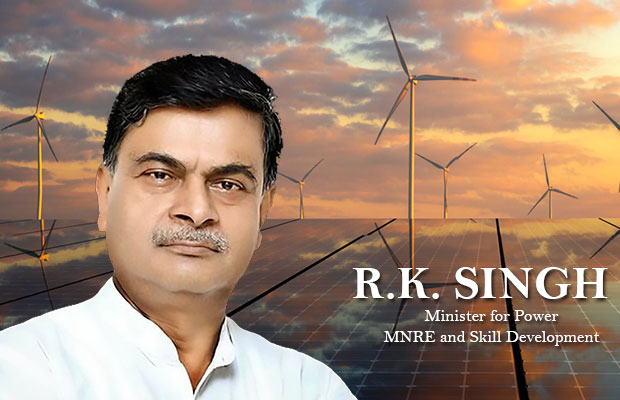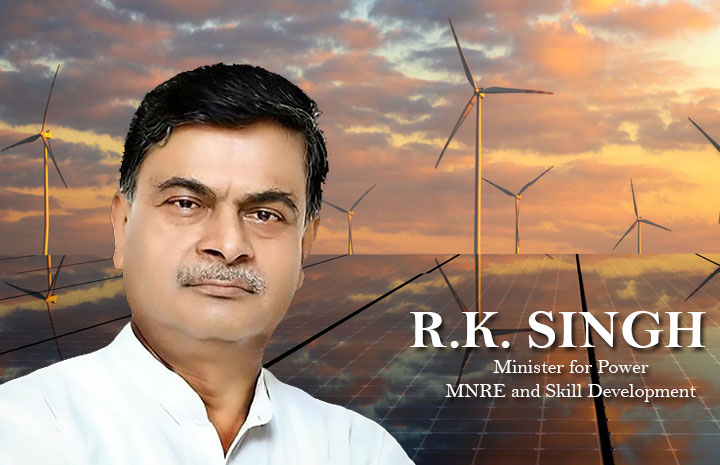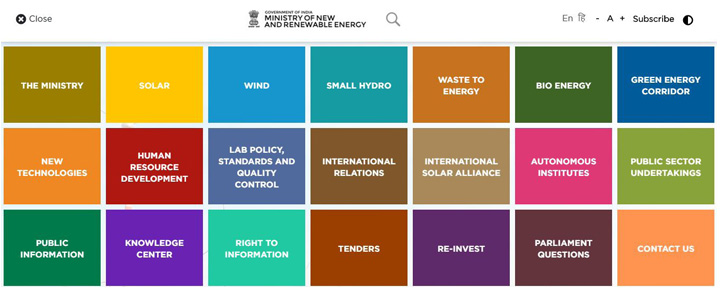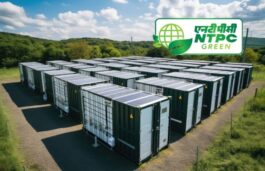

Union Power Minister R.K. Singh will complete 3 years of his association with the Power Ministry on September 3 this year. 2020 could be the year that defines his tenure. Ever since his appointment as the Minister of Power (Independent Charge) in Prime Minister Narendra Modi’s cabinet, he has found himself in the idle of a sector in transition. He earned his spurs quickly enough, and on 30 May 2019, he was appointed as Minister of State (Independent Charge) of the Ministry of Power, Minister of State (Independent Charge) of the Ministry of New and Renewable Energy and Minister of State in the Ministry of Skill Development and Entrepreneurship.
Mr Singh found himself in the middle of a ‘boom’ in renewable energy in his first term, with India adding 10.3 GW of solar capacity in 2017-18. 2016-17 had been even better, with 11.3 GW added. This was largely on the back of the agility his predecessor, Piyush Goyal, himself a Minister of State with Independent Charge of Power between 2014 to 2017, showed. Mr Goyal was quick to spot the new reality of solar power, with prices dropping fast, strong interest among global players to see India emerge as a key market, and the country’s own Paris accord commitments to fighting climate change. India revamped its renewable energy target to 175 GW, with Solar expected to deliver a bulk of this at 100 GW by 2022. For Solar, the 5 fold jump from 20 GW to 100 GW opened up the floodgates. Helped by low import restrictions and the support of southern states initially, the spike during 2015-2017 was unprecedented. This is where Mr Singh found himself in 2017, before things started going south.
The problems, typical to India’s controlled economy were predictable. As projects went live, the discom issue reared up. In the form of payment delays. Pressure to keep prices low to get discoms support resulted in margins being shaved to the barest minimum, the consequences of which are still being felt. July 2017 saw the introduction of the Goods and Services Tax (GST), which spared no sector, including Solar EPC, from its impact. While all this was happening, rumblings from domestic manufacturers were growing louder all the time, culminating in an investigation by the Directorate General of Trade Remedies (DGTR), a body under the commerce ministry. By July 2018, the DGTR had recommended a graded safeguard duty (SGD) on import of solar cells from China and Malaysia, with the last of the reduced duties set to go by this July. The Safeguard duty proved to be a big blow, slowing down bidding, sparking off litigation from bidders who had won projects before the duty came in, and of course, a demand to allow price escalations from developers. Post SGD, India’s still thriving solar tenders started seeing their first slowdown in participation , with many tenders undersubscribed or even forced to be cancelled.
In 2019 too, July was to prove to be a cruel month, with the new state government of Jagan Mohan Reddy in Andhra Pradesh, delivering on its threats to renegotiate rates on older PPA’s. Coming from one of the states with the highest number of renewable projects, this was a big blow, and sent shockwaves through an embattled industry. The result of all this? In August last year, a report from the Central Electricity Authority (CEA) estimated total discom dues to renewable energy developers across 513 projects at Rs 9,735 crores. Even this figure was probably lower than the actual number, as a prominent developer chose to opt out, not wanting to drag their issues in the open just yet. In fact, if the dues of 1722 crores of this developer were to be added, then the final figure would have been Rs 11458 crores. Delays, cancellations, and frustrations around policy. What was new for a sector with a high government involvement? Quite a lot, going by the efforts Mr Singh and his MNRE ministry has made over the past few months. Which brings us to the 5 tasks, where, progress could mean all the difference between a thriving solar and renewable energy sector or complete distress , by 2021. India, where a crisis seems to be the only way to shake up things for food, the Coronavirus crisis could indeed mean the biggest reforms ever.
1. Passage of the Electricity (Amendments) Bill, 2020. The proposed new bill is now in its final stage, with feedback from stakeholders awaited till June 5, before it progresses to the next stage. The bill, and the amendments proposed in it, has done as exhaustive a job as one could expect, to provide some serious long term direction and rule of law to the sector. Ever since it was introduced to the public domain in April this year, the proposed Act has sent a surge of expectations through the renewable sector. For three main reasons, and sundry associated ones. Key is the attempt to give the backing of the central law to key notifications issued by the ministry . These include timely payments to all genco’s, ( in advance or against LC’s), deemed generation status to RE projects whenever any discom ties to curtail generation without a strong reason like grid safety, and strict implementation of Renewable Purchase Obligation(RPO) norms for renewable energy, which will force lagging discoms to tighten up.
As outlined by Mr Singh himself in a recent interaction with industry CEO’s, state governments had a vested interest in maintaining status quo, when it came to discoms. In fact, states like Tamil Nadu, Bihar and Telangana have already pitched to postpone the passing of the bill. But they need to be resisted, firmly.
Options like private discoms, starting with union territories, are bound to face resistance , as they have. Steps like a national selection committee that will fill state regulatory commissions are bound to be seen as an attack on state autonomy. As is the move to make the National Load Despatch Centre pre-eminent over State level centres.

The bill, quite simply, seems to be premised on the view that the plight of the power sector is primarily due to the failure of states to use their power responsibly, and hence the need to take away or neutralise a lot of that influence. That view is attractive for those in a hurry to see things done, but we believe a balancing act will be required by the minister to ensure that such sharp changes donot make this an all out confrontation between the centre and states.
On the sub-licensee provision at discom level, industry insiders have expressed worries at the lack of clarity on rules. Or the removal of cross subsidization of power, which has the noble intention of making power cheaper for industry too. The question is can the sector be trusted to deliver quality power at a fair price to the common consumers? The discom mess has been a long time in the making, and already the Rs 90,000 crore stimulus is looking inadequate as everyone lines up for support. By far, the toughest and most important challenge for Mr Singh. The good news? He seems to have the full backing of his boss, and the man who matters, Prime Minister Narendra Modi.
2. Ensuring a solid footing for the energy storage sector. The Minister has reason to be hopeful of achieving much here. Starting with the resounding success of the latest 400 MW Renewable+ Storage tender. Renew Power bid for round the clock power, the holy grail for any energy source to be considered mainstream, at a very attractive Rs 2.90 per kWh. (Levelised tariff of Rs 3.52 kWh over 15 years) .The winning bid, and even the interest from other bidders, clearly demonstrates that when it comes to storage, the future is here, with Solar + Storage making a strong case for itself purely on costs over thermal power. Storage is also one area where India’s manufacturing ambitions have a much better chance of reaching fruition, unlike solar equipment, where China simply outinvested everyone with huge capacities.
With storage, India has a chance to ensure that it’s well outlined 50GW capacity target for make in India has a chance to come true. Many pre-conditions, in terms of market readiness, a build up demand to keep pace with supplies, and dropping costs, could help make it happen.
It was in March last year that the government launched its National Mission on Transformative Mobility and Battery Storage with an aim to set up 10 Gw of manufacturing in India by 2022, and 50 GW by 2025. 15 months later, word is that we are very close to launching these tenders with special incentives for manufacturers. With the investing climate never better than it is presently, at least in terms of government support at both central and state levels , the storage push can’t come sooner.
3. Rooftop Solar. Government loves big. We get that. It is more visible, grabs headlines, attention, and involves big ticket investments. But in solar, small, or at least the relatively small, in the form of rooftop solar can also pack quite a punch. Besides creating ground level demand for domestic manufacturers, the commercial and industrial market as it is called, for industrial sized rooftop solar, can also be a huge driver of investments and generation. For years together, rooftop solar has been left to fend for itself, with the now standard ‘central subsidy’ delivering poor to fair results in just a few states. The problem for interested consumers and corporate customers starts right at the search stage.
There is an unholy mess of regulations, costs and quotas stifling the sector, with new rules for virtually every state. Headline numbers of residential solar rooftops ranging from Rs 22,000 to Rs 37,000 across states today are almost meaningless on the ground. Vendors who have empaneled to get a foot in to the market , confuse the issue even further with customers, as they seek to protect their margins. A national resource with statewise data and resources is the minimum requirement, if not the promised single window clearance for applications.
In the commercial and industrial market too, states like Gujarat have found ingenious ways to block growth, by first pushing for capex projects, and later, making projects dependent on discom NOC’s. Something they have been unsurprisingly loathe to give. In this case, the Gujarat model if rolled out nationally, will be a disaster for the whole sector.
4. Speed up the Central Public Sector Undertaking (CPSU) program for the development of solar projects worth 12GW. The CPSU scheme seeks the setting up of setting up of 12,000 MW grid-connected solar PV projects by CPSUs /State PSUs/ Government Organisations, with Viability Gap Funding (VGF) support for self-use or use by Government/ Government entities, either directly or through discoms. Under the scheme, a total of 12 GW of solar projects is expected to be tendered under the second phase of the scheme. According to the ministry, 4 GW was to be tendered in FY 2019-2020, followed by another 4 GW in FY 2020-2021 and then in 2021-2022. All the projects are expected to be developed by the end of FY 2022-2023. Under the CPSU program, the usage charges should not exceed Rs 3.50/kWh and will be exclusive of any other third-party charge such as wheeling, transmission, and the likes. The issue here, as always, has been the speed of execution. With such a huge number of available CPSU’s and other government bodies eligible, the process has actually frozen down. There is a need, articulated by the minister himself recently, to give the job to a fee select PSU’s, if this scheme is ever to finish. It’s a thought we are happy to endorse, and wait to see it put into action soon.

With their promise of volume off take over the next 3 years from domestic manufacturers, the scheme can also provide a much needed fillip to domestic manufacturers, whose biggest grouse is lack of visibility in future orders, and frequent disruptions in the past two years. In fact, increasing the volumes here and speeding up the process might be a far better idea than tinkering with the duty on imports, which looks set to go up again. Simply because duties, especially high duties, have built up a perfect record of breeding inefficiencies and passing on these costs to the end consumer in the form of higher power prices.
5. Revive The ISA. The International Solar Alliance has not exactly gone into hibernation, but the signs are not good. A visit to the site of the prestigious initiative is indicative of the tiredness that has affected the organization too. While inaccessible at the time of writing this, the last time we did track it, it had been months, even years since fresh information and data had been added.
Founded in November 2015, by Prime Minister Modi and President Hollande of France, the organisation has an ambitious objective to The primary objective of the alliance is to work for efficient exploitation of solar energy to reduce dependence on fossil fuels. For this, it seek to mobilise a trillion dollars by 2030, that will support the effort to make solar energy affordable and a larger part of the energy mix across its 122 members at last count.
The ISA is an initiative that Prime Minister Modi, and Mr Singh as Co-President of the Isa assembly are justifiably proud of the initiative, considering the fact that it is the second largest global organisation after the UN, in terms of member countries. However, like other large organisations, the ISA too seems to have fallen prey to the familiar challenges of a slow decision making, paper pushing, and meetings with no serious impact or outcome. As India’s biggest move towards combating climate change, the ISA needs to show far more for its 4 plus years of existence, than the global tender for 2,72,000 Solar pumps where it did drive prices down significantly, it has to be said.
With the EU, and many other key regions increasingly talking about a green stimulus, it is upto organisations like the ISA to grab the opportunity and grab the new found respect and interest in solar energy as an option.



























